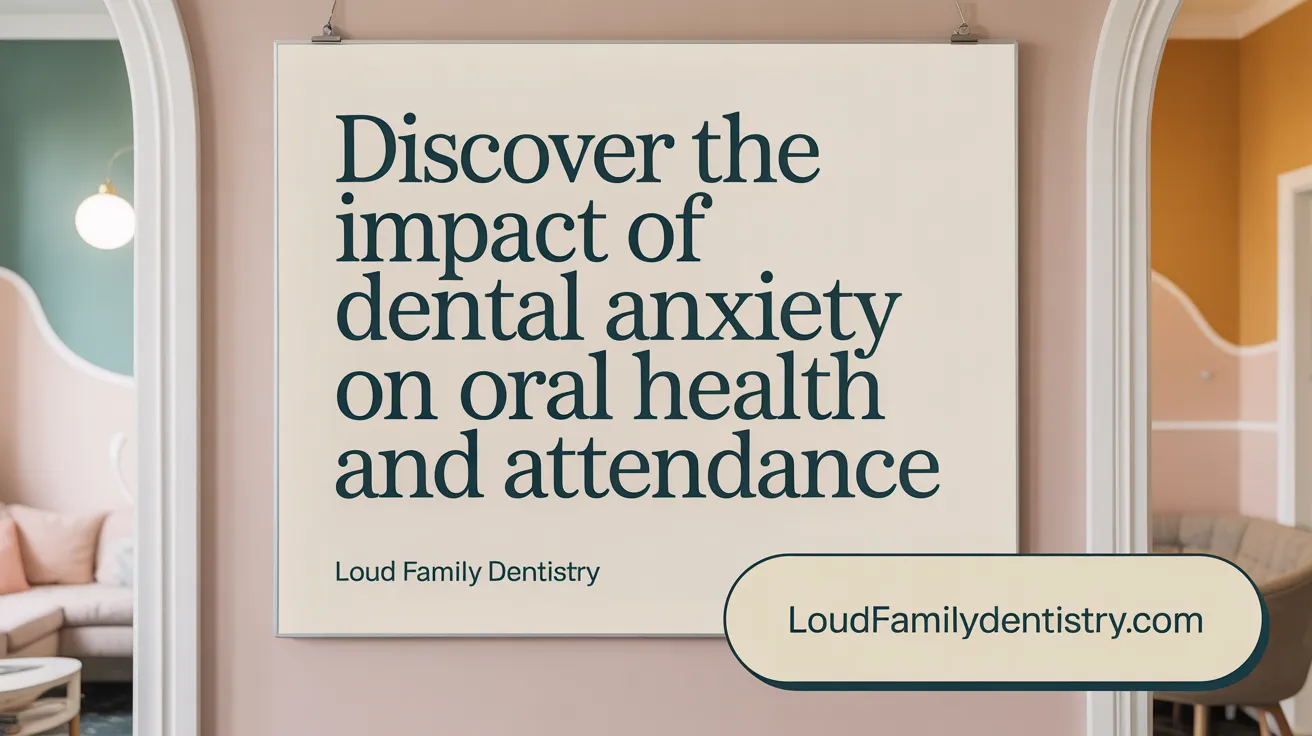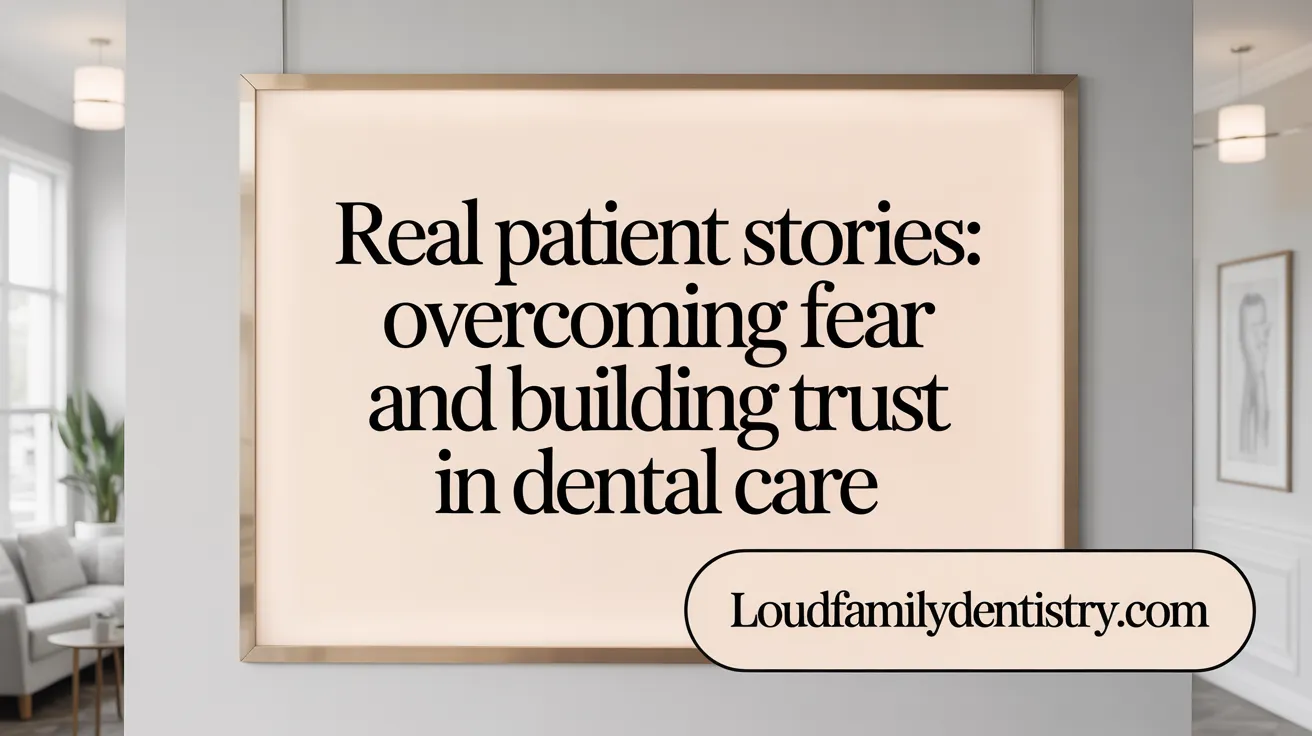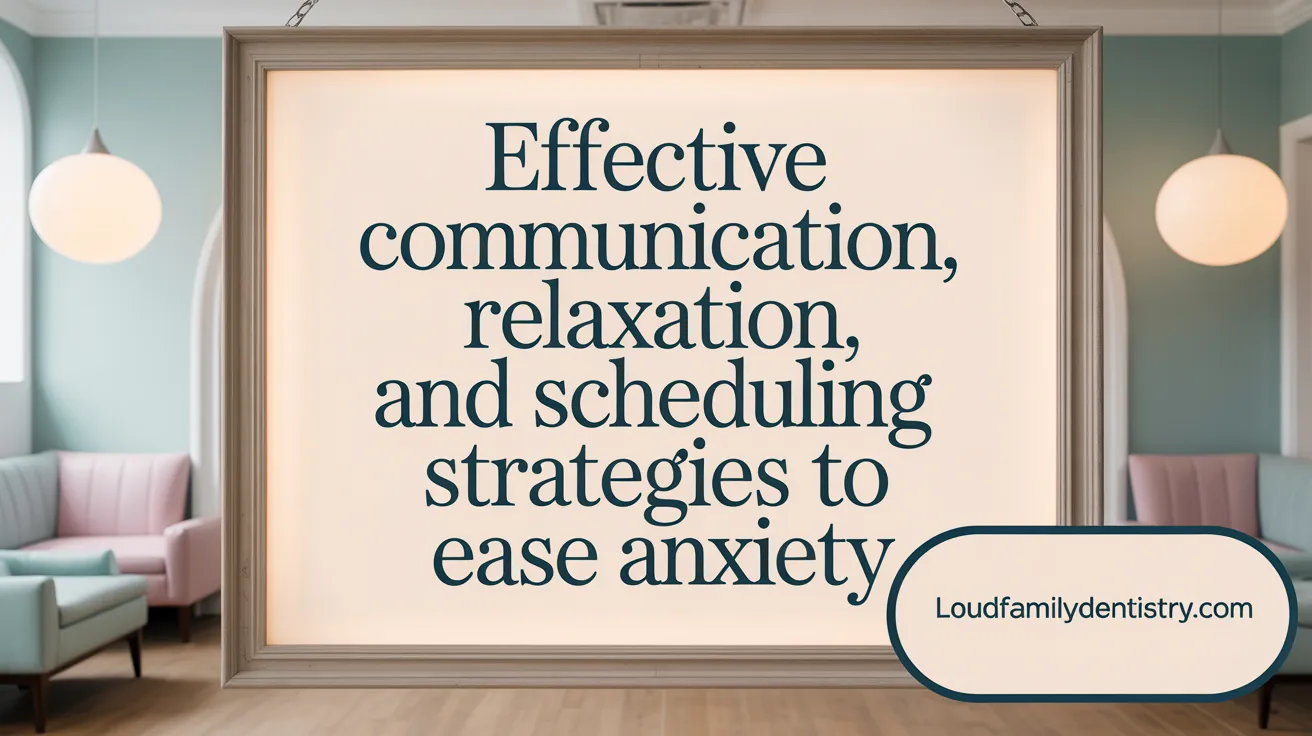Understanding the Challenge of Dental Anxiety
Dental anxiety affects millions worldwide, often deterring patients from receiving essential oral health care. This widespread issue stems from a complex interplay of biological, psychological, and experiential factors, creating a cycle of avoidance and deteriorating dental health. In this article, we share compelling patient stories and explore modern strategies that help conquer fears, rebuild trust, and transform the dental experience into one of comfort and confidence.
The Roots and Reality of Dental Anxiety

What is dental anxiety and how prevalent is it?
Dental anxiety is a fear or significant stress related to visiting the dentist and dental procedures. It affects a large portion of the population—between 50% and 80% of adults worldwide experience some form of dental anxiety. Approximately 12% of these individuals have extreme dental phobia, which is a more intense and debilitating fear that often leads to avoidance of dental care.
What are the main causes of dental anxiety?
Dental anxiety arises from a variety of causes. Past traumatic or painful dental experiences are among the most common triggers. Fear of needles, pain, loss of control, and embarrassment can also provoke anxiety. Media portrayals of dental visits often reinforce negative stereotypes that exacerbate fear. Biological factors like the body's innate fight-or-flight response play a role, as does the presence of psychological conditions such as post-traumatic stress disorder (PTSD) and generalized anxiety disorder. For a deeper explanation of causes and management, see dental anxiety causes and psychological factors.
How does dental anxiety manifest?
Physiological symptoms of dental anxiety include increased heart rate, sweating, nausea, trembling, and fainting. Patients may show visible signs of distress and often have behavioral reactions such as withdrawal or, alternatively, aggressive or humorous attempts to mask their anxiety. These manifestations highlight the powerful psychological and physical effects dental anxiety can have. More on these symptoms and manifestations can be found in physiological responses to dental procedures.
What is the impact of dental anxiety on dental attendance?
Dental anxiety greatly influences patients' behaviors toward dental care. Many avoid or delay dental appointments, often only seeking treatment when pain becomes severe. This avoidance leads to worsening oral health issues such as cavities, gum disease, and tooth loss. The delays in care frequently require more complex and invasive dental procedures. This pattern creates a vicious cycle where anxiety leads to avoidance and worsening oral health, which then amplifies fear and avoidance further. For insights on this cycle and its consequences, visit effects of dental anxiety on oral health and attendance.
Patient Perspectives: From Fear to Trust

How do patients describe their experiences with dental anxiety?
Many patients recount dental anxiety beginning in childhood, often linked to traumatic dental visits or negative experiences. The fear typically centers on pain, fear of needles, feeling a loss of control, and the intimidating aspects of the clinical environment such as loud noises and unfamiliar smells. For some, memories of past distress or embarrassment deepen their reluctance to seek care, sometimes resulting in avoidance that worsens oral health. For more details, see Dental Fear Survey and physiological responses and Cycle of avoidance in dental anxiety.
What helps patients build trust with their dentists?
Trust grows when dentists engage in open and honest communication, explaining procedures in simple terms and addressing patients' fears directly. Personalized care, where dental teams listen attentively and respect individual concerns, significantly reduces anxiety. Patients appreciate when dentists provide options such as sedation or relaxation techniques and encourage questions. Small gestures like allowing breaks through hand signals and offering comfort items, like blankets or headphones, foster a supportive atmosphere. Related strategies include Communication techniques for anxious patients and Managing dental anxiety with sedation.
Role of dental team and environment in easing fear
A welcoming dental environment with amenities like soft blankets, music, and noise-canceling headphones creates physical and emotional comfort. Friendly, empathetic staff who understand dental anxiety play a crucial role by offering reassurance and calm communication throughout visits. This comprehensive approach—combining thoughtful environmental cues with compassionate care—helps patients transition from fear to confidence, encouraging regular dental visits and better oral health outcomes. For more information, see Patient comfort amenities and environmental setup and Creating a Calm Dental Atmosphere.
Innovations and In-Office Comfort Measures

What technological advances reduce dental anxiety and pain?
Modern dentistry has embraced numerous technological advancements that have substantially reduced patient discomfort and anxiety. Digital X-rays with less radiation, for instance, emit significantly less radiation compared to traditional methods and produce quicker results, minimizing the time patients spend during diagnostics. Computer-controlled local anesthesia systems precisely deliver anesthetics with minimal pain, alleviating the fear commonly associated with injections. Noise-reducing dental tools further reduce discomfort by enabling less invasive procedures and lowering the noise and vibration from drills, which are frequent anxiety triggers. Additionally, noise-reducing devices help diminish the distress caused by the typical sounds of dental treatment.
How do dental offices make patients more comfortable?
Dental practices now prioritize patient comfort by incorporating various amenities and modifications aimed at easing anxiety. Patients can expect plush, ergonomically designed chairs equipped with lumbar and neck support to enhance physical comfort. Weighted blankets and aromatherapy in dentistry create a soothing environment, while noise-canceling headphones allow patients to listen to calming music, distracting them from clinical sounds. Waiting areas often feature calming ambiance with soft lighting and gentle music. Distraction tools such as ceiling-mounted televisions and personalized entertainment options keep patients relaxed during procedures. These patient comfort amenities contribute significantly to reducing dental anxiety.
What sedation options are available for anxious patients?
To further enhance comfort, dental offices offer several sedation dentistry for relaxation options tailored to the levels of patient anxiety. Nitrous oxide, commonly known as laughing gas, provides mild sedation that helps patients relax while remaining conscious and responsive. Oral sedatives serve as a more potent option for those with moderate anxiety, helping to reduce nervousness before and during treatment. For patients experiencing severe anxiety or requiring extensive procedures, intravenous sedation for dental treatment offers a deeper, controlled state of relaxation. In rare, complex cases, general anesthesia in dental treatment may be employed to ensure the patient is completely unconscious and pain-free throughout the procedure. These sedation methods are carefully chosen based on individual patient needs, anxiety severity, and medical history, ensuring a comfortable and safe dental experience.
Patient Success Stories: Journey Through Anxiety to Comfort
Can you provide examples of patients who overcame dental anxiety?
Many patients have shared inspiring stories about overcoming dental anxiety. For instance, Gary's severe anxiety stemmed from childhood traumatic dental experiences. With the support of a dental team that employed intravenous sedation, Gary completed multiple tooth extractions in a pain-free session, restoring his faith in dental care. Similarly, Christopher, treated at NYC Smile Spa, benefited from a gradual exposure approach and a spa-like environment featuring calming music and comforting amenities, helping him build confidence and improve his quality of life.
How do personalized care approaches help in overcoming anxiety?
Personalized dental care plays a vital role in easing patient fears. Dentists who practice open, clear communication help patients understand procedures beforehand, which reduces uncertainty. Staged exposure to treatment, starting with less invasive steps, allows patients to build trust and control. Use of sedation options such as nitrous oxide or intravenous sedation combined with patient empowerment techniques like hand signals for breaks enhance comfort and manage anxiety effectively.
What are the benefits of overcoming dental anxiety?
Overcoming dental anxiety offers significant health and social benefits. Patients report improved oral health due to regular visits, better management of dental conditions, and prevention of complex procedures. Confidence in dental settings leads to more consistent care and improved nutrition as patients can maintain healthy teeth. Enhanced social interactions and self-esteem often follow, as patients no longer hide their smiles or avoid dental care due to fear. For more on this, see Overcoming dental anxiety and its benefits.
Practical Strategies and Techniques for Managing Dental Anxiety

What communication strategies help manage dental anxiety?
Effective communication is fundamental in managing dental anxiety. Dentists who explain procedures thoroughly before treatment can significantly ease patients' fears by demystifying the process. Encouraging patients to ask questions and express concerns openly fosters a sense of control and trust. Additionally, using simple hand signals during treatment allows patients to indicate when they need a break, further empowering them and reducing feelings of helplessness and apprehension.
What relaxation and distraction techniques can patients use?
Patients can employ various relaxation and distraction methods to calm anxiety during dental visits. Deep breathing exercises, such as slow diaphragmatic breathing, help activate the body's relaxation response. Techniques like guided imagery and progressive muscle relaxation reduce tension and focus the mind away from discomfort. Listening to music, watching videos, or holding stress balls serve as effective distractions, diverting attention from dental sounds and sensations that may trigger fear.
What psychological therapies support dental anxiety management?
Several psychological therapies are effective in managing dental anxiety. Cognitive-behavioral therapy (CBT) is highly regarded for helping patients identify and restructure negative thoughts about dental care. Exposure therapy gradually introduces patients to feared situations in a controlled manner to reduce avoidance behavior. Other methods like hypnotherapy and systematic desensitization contribute to lowering anxiety levels by promoting relaxation and positive associations with dental treatment.
How can scheduling and appointment practices ease anxiety?
Practical scheduling can make dental visits less stressful. Appointments booked during less busy times of the day help reduce waiting and exposure to a stressful environment. Arriving early offers patients time to relax and acclimate to the setting. Starting treatment plans with shorter or less invasive procedures can build trust and confidence, gradually preparing patients for more involved care. Together, these strategies create a patient-centered approach that acknowledges and alleviates dental anxiety.
The Road Ahead: Emerging Tools and Ongoing Support
What emerging tools assist dental anxiety management?
Innovative digital technologies are reshaping how dental anxiety is addressed. Smartphone apps like Dental FearLess app offer cognitive-behavioral therapy (CBT) and mindfulness techniques remotely, allowing patients to prepare and manage their fears before dental visits. Meanwhile, virtual reality is gaining attention as both a distraction and an exposure tool, immersing patients in calming environments or simulated dental procedures to ease anxiety (Virtual reality for dental anxiety).
How important is continuous support?
Sustained reduction of dental anxiety requires a combined approach. Psychological therapies, such as CBT and relaxation techniques, when integrated with pharmacological options like nitrous oxide or sedation, provide comprehensive relief (Psychotherapeutic interventions for dental anxiety). Ongoing patient education and communication further enhance comfort, promote trust, and encourage regular dental attendance, preventing escalation of dental fears (Managing dental anxiety).
What role does patient education play?
Informing patients about dental procedures, pain management strategies, and comfort amenities empowers them. Education dispels myths, sets realistic expectations, and reduces fear of the unknown (Dental anxiety solutions). Community awareness initiatives extend support beyond individual clinics, fostering a culture where dental anxiety is openly discussed and managed, ultimately breaking the cycle of avoidance and poor oral health (Addressing dental fear and anxiety to improve oral health outcomes).
Finding Comfort and Confidence in Dental Care
Dental anxiety remains a formidable barrier to oral health, but modern dentistry coupled with compassionate, tailored care offers hope and healing. Through patient stories, technological advances, and evidence-based techniques, fear can be transformed into trust and comfort. Regular dental visits, supported by a caring dental team and personalized strategies, empower patients to maintain healthier smiles and improved quality of life. Overcoming dental anxiety not only restores oral health but also enriches emotional well-being, opening the door to a lifetime of confident dental care.
